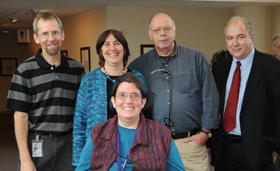NHGRI’s LaMarca Ends Career Here
 |
| Recent retiree Mary LaMarca (c) is joined by (from l) Dr. Eric Green, Dr. Ellen Sidransky, LaMarca’s husband George Stephens and Dr. Edward Ginns, NINDS. |
Mary LaMarca, a biologist in the Medical Genetics Branch, NHGRI, recently ended her career after more than 20 years at NIH.
“What a wonderful career I have had. I couldn’t have done it without you,” she told friends and colleagues who gathered at her farewell reception at the Clinical Center.
Over the course of her 30 years in biomedical research, LaMarca contributed to the authorship of more than 30 papers, most of which explored the genetics of Gaucher disease, a lysosomal storage disorder. The researcher and her colleagues hold patents in the United States and Israel for cloned DNA for synthesizing glucocerebrosidase, the enzyme that is defective in Gaucher disease. LaMarca was part of the team that created the first mouse model of Gaucher disease, reported in a 1992 issue of Nature, and she developed mouse models for other storage diseases including Pompe and aspartylglycosaminuria.
In the past year, she co-authored the most complete database of mutations observed in Gaucher disease, which was published in the journal Human Mutation. Most recently, she received a 2008 NIH Director’s Award for exceptional contributions to the goals of the Medical Genetics Branch.
In the section on molecular neurogenetics, LaMarca designed and performed experiments at the bench, used her keen editing and writing ability and served as the lab’s institutional memory. Her section chief, Dr. Ellen Sidransky, said, “I have truly benefited from her wisdom, integrity, humor, insight, bluntness and courage over the past years, and will miss her regular counsel and presence dearly.”
In December 2004, LaMarca was diagnosed with amyotrophic lateral sclerosis (ALS, also known as Lou Gehrig’s disease). In spite of her progressive disability, she continued working.
“ALS is a rare disease, and its causes are still unknown,” she said. “My experience studying Gaucher disease, another rare disorder, has taught me that none of our research would be possible without the patients and their families who permit us to study their DNA and their symptoms.”
She donated DNA to an NINDS-sponsored ALS repository, volunteered for a natural history study of potential neuropsychiatric and MRI indicators of ALS and has directed that her brain and spinal cord be donated to a tissue bank for ALS research after her death.
Fauci Wins a ‘Freddie’
NIAID director Dr. Anthony Fauci was awarded the MediMedia Foundation Public Service Award (“Freddie Award”) at a recent ceremony in Philadelphia, for outstanding contributions to the field of infectious diseases.